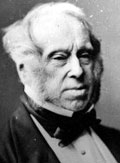 |
Henry John Templeb. 20 Oct 1784, London |
| Ministerial offices: | Lord of the Admiralty (6 Apr 1807 - 26 Oct 1809) |
| Secretary at War (27 Oct 1809 - 26 May 1828) | |
| Secretary of State for Foreign Affairs (22 Nov 1830 - 17 Nov 1834, 18 Apr 1835 - 30 Aug 1841, 6 Jul 1846 - 26 Dec 1851) | |
| Secretary of State for Home Affairs (28 Dec 1852 - 6 Feb 1855) | |
| First Lord Commissioner of the Treasury (6 Feb 1855 - 19 Feb 1858, 12 Jun 1859 - 18 Oct 1865) | |
| Names/titles: | 3rd Viscount Palmerston of Palmerston, Co. Dublin, and Baron Temple of Mount Temple, Co. Sligo [from 16 Apr 1802] |
| Biography: | |
Henry John Temple was the eldest surviving son of the 2nd Viscount Palmerston. He went to Harrow School and studied at the Universities of Edinburgh and Cambridge receiving his MA degree at St. John's College, Cambridge, in 1806. Before he completed his education, Temple succeeded to the viscountcy after his father's death in 1802. As Irish peer, he was elected to the House of Commons for the first time in 1807 as a Tory (MP, 1807-1865). In 1826-1830 he allied himself with the Canningites, but later joined the Whigs in the government of the 2nd Earl Grey as Foreign Secretary (1830-1834). His policy was to further British interests, including trade, by making neither friends nor enemies. Although his style could be impulsive, hot tempered and at times high handed, he sustained a certain popularity with the people, who saw him as a winner. He made steps to secure the independence of Belgium (1831-1832) and set up the Quadruple Alliance between Britain and France, agreeing to support the Liberal governments in Spain and Portugal (1834). In 1841-1846 he was in opposition to the Government, but returned as Foreign Secretary (1846-1851) under Lord John Russell. Palmerston's independence in making decisions outraged his colleagues in the Cabinet and when he openly approved the coup in France by President Louis-Napoléon Bonaparte, Russell insisted on his dismissal (19 Dec 1851), but Palmerston refused to deliver the seals of office to the Queen until 26 Dec 1851. He contributed to the fall of the Russell government in February 1852 and assumed the post of Home Secretary (1852-1855). When the Earl of Aberdeen failed and resigned in January 1855 Palmerston, despite his age of 70, was the obvious successor. Queen Victoria appointed him First Lord of the Treasury and prime minister on 6 Feb 1855. By 1856 the Palmerston's Liberal government successfully concluded the Crimean war, but he was defeated in the House of Commons over his aggressive China policy (3 Mar 1857). He promptly called and won a General Election in 1857 increasing the Liberal majority up to 100. Palmerston's popularity also increased after the effective suppression of the Indian Mutiny (1857). A year later Palmerston was again defeated in the Commons during the Conspiracy to Murder Bill and resigned on 19 Feb 1858. In 1859 the modern Liberal Party was born with Palmerston as Leader (Feb 1855 - Oct 1865). The resignation of Derby, defeated in the House of Commons, enabled Palmerston to form his second administration, where he himself again assumed the post of First Lord of the Treasury (12 Jun 1859). Much of the next six years was concerned with foreign policy in all quarters of the world. Palmerston supported the Southern states in the American Civil War, although refusing to recognize the Confederacy. He failed to defend Denmark against Bismarck in the Schleswig-Holstein question and this problem led to his censure in the Lords (June 1864). In July 1865 Palmerston called a General Election, which helped him to enlarge the Liberal majority (Liberal 370, Conservative 288), but died (18 Oct 1865) before Parliament reassembled. Biography source: [1, pp. 177-186] |
|
| | |
| [1] | Englefield, Dermot; Seaton, Janet; White, Isobel (eds.) Facts About the British Prime Ministers: A Compilation of Biographical and Historical Information. New York: The H.W. Wilson Company, 1995. online |
| Image: photograph of Viscount Palmerston, c. 1840. | |
